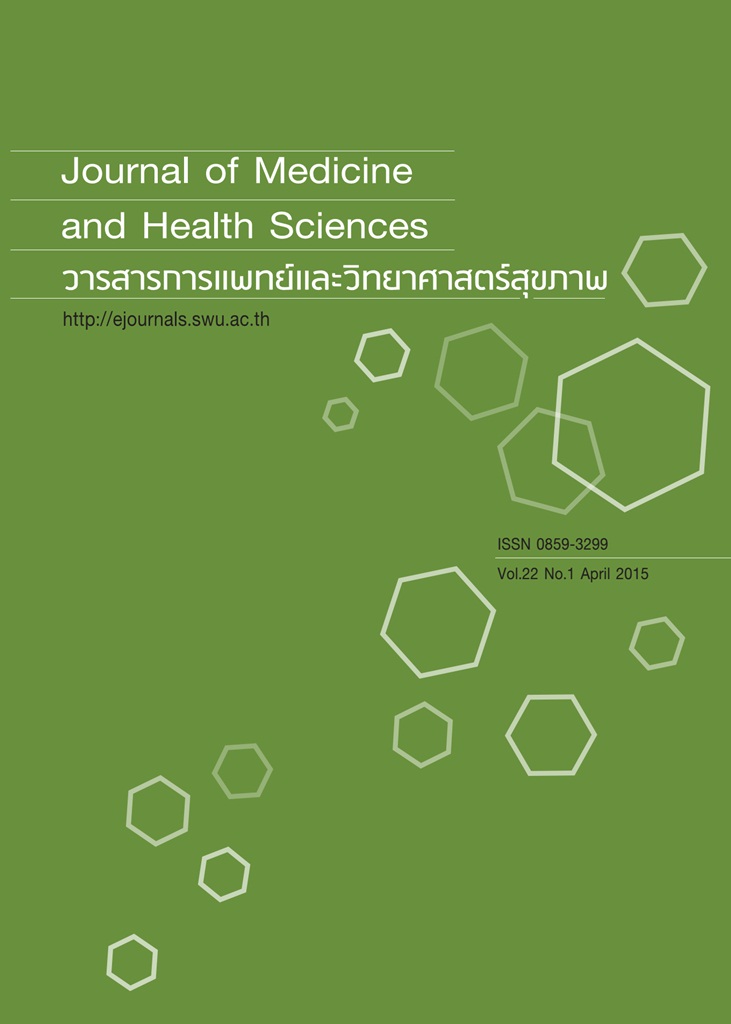Effects of Active Scapular Retraction during Shoulder Flexion 60 Degree on Pectoralis Minor Muscle Length and Forward Shoulder Angle
Keywords:
rounded shoulder posture, scapular retraction, stretchingAbstract
Posture control in fault position such as forward shoulder angle results in pectoralis minor decreasing in length. Appropriate muscle stretching technique could increase muscle length and posture may be realign into a good position by reduction in forward shoulder angle (FSA). Fifty eight healthy participants with averaged age of 20.9 years and right arm dominant were included. After pectoralis minor stretching, pectoralis minor length was measured by digital vernier caliper and forward shoulder angle was measured from side view photograph in upright sitting by Kinovea program. The stretching was performed 2 rounds by active retraction at shoulder flexion 60°. Each round includes 3 consecutive sets of 20-second hold and 10-second rest. Mean differences of pectoralis minor length and forward shoulder angle before and after stretching were statistically significant (p < 0.001). Pectoralis minor length was increased 1.99 mm. (95%CI 1.27, 2.72), but forward shoulder angle was decreased 3.6° (95%CI 5.2, 2.0). In addition, pectoralis minor length was correlated with forward shoulder angle (p<0.01). Active scapular retraction following this study caused an immediate effect on increased pectoralis minor length and reduced forward shoulder angle using two dimensional measurement.
ผลของ active scapular retraction ในท่างอข้อไหล่ 60 องศาต่อความยาวกล้ามเนื้อ pectoralis minor และ forward shoulder angle
การทรงตัวในท่า forward shoulder angle ส่งผลให้กล้ามเนื้อ pectoralis minor มีความยาวลดลง การยืดกล้ามเนื้อ ด้วยวิธีที่เหมาะสมช่วยเพิ่มความยาวกล้ามเนื้อและช่วยปรับให้มีท่าทางที่ดีได้โดยสามารถลดมุม forward shoulder angle อาสาสมัครสุขภาพดีจำนวน 58 คน อายุเฉลี่ย 20.9 ปีและมีความถนัดด้านแขนขวาได้รับการวัดความยาวกล้ามเนื้อ pectoralis minor ด้วย digital vernier caliper และวัด forward shoulder angle จากภาพถ่ายด้านข้างท่านั่งตรงด้วย โปรแกรมKinovea หลังการยืดกล้ามเนื้อ pectoralis minor2รอบด้วยท่า activescapular retractionขณะที่ shoulder flexion 60° โดยยืดค้างไว้เป็นเวลา 20 วินาทีพักเป็นเวลา 10 วินาทีและทำการวัดติดต่อกัน 3 ครั้งต่อรอบ การศึกษานี้ พบความแตกต่างทั้งความยาวกล้ามเนื้อ pectoralis minor และ forward shoulder angle อย่างมีนัยสำคัญทางสถิติ (p < 0.001) โดยความยาวเฉลี่ยของกล้ามเนื้อ pectoralis minor เพิ่มขึ้น 1.99 มม. (95%CI 1.27, 2.72) แต่ forward shoulderangleเฉลี่ยลดลง 3.6° (95%CI5.2,2.0)และความยาวกล้ามเนื้อ pectoralis minorมีความสัมพันธ์กับ forward shoulder angle (p < 0.01) การยืดกล้ามเนื้อ pectoralis minor ในท่า active scapular retraction ขณะที่ shoulder flexion 60° มีผลเพิ่มความยาวกล้ามเนื้อ pectoralis minor และลด forward shoulder angle ทันทีหลังการยืดเมื่อใช้ วิธีวัดสองมิติ



